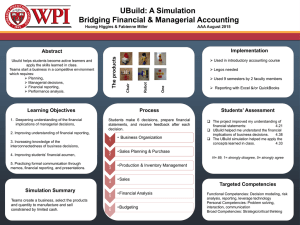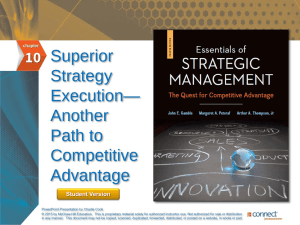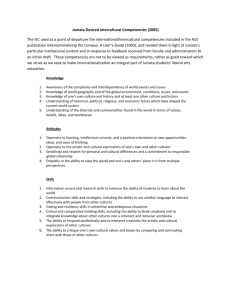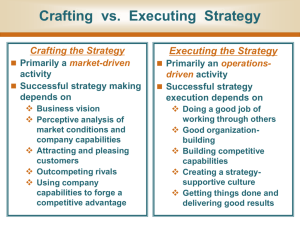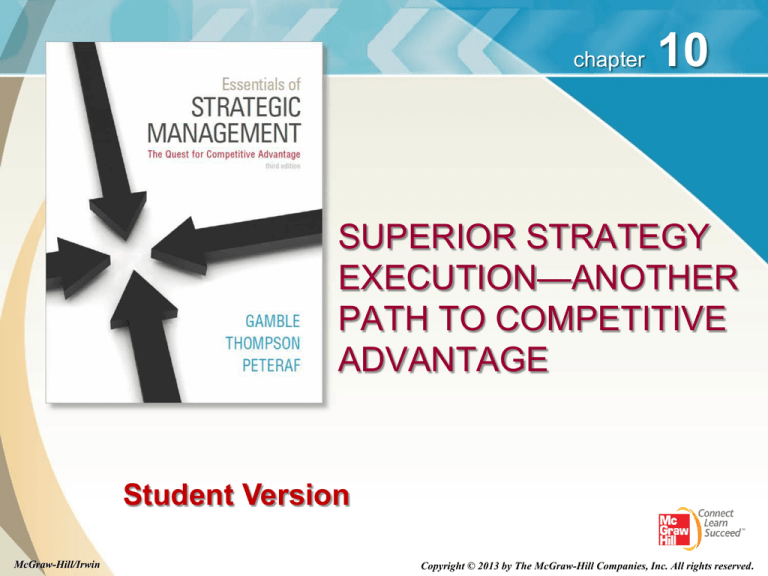
chapter
10
SUPERIOR STRATEGY
EXECUTION—ANOTHER
PATH TO COMPETITIVE
ADVANTAGE
Student Version
McGraw-Hill/Irwin
Copyright © 2013 by The McGraw-Hill Companies, Inc. All rights reserved.
Crafting versus Executing Strategy
Crafting the Strategy
Executing the Strategy
Primarily a market-
Primarily an operations-
driven activity
Successful strategy
making depends on
driven activity
Successful strategy
execution depends on
management’s ability to
Attracting
and pleasing
customers
Outcompeting rivals
A firm’s collection of
resources and capabilities
Direct
change
Improve operations
Build a strategy-supportive
culture
Get things done and deliver
good results
10-2
Who Is Responsible for Implementation
of the Chosen Strategy?
The organization’s chief executive officer and other
senior managers are responsible for ensuring that
the strategy is executed successfully.
It is middle and lower-level managers who must see
that employees and work groups perform the
strategy-critical activities that result in achievement
of the firm’s performance targets.
All managers are involved and thinking:
“What does my area have to do to implement its part of the
strategic plan, and what should I do to get these things
accomplished effectively and efficiently?”
10-3
Principal Managerial Components
of the Strategy Execution Process
1. Building an organization with the capabilities,
people, and structure needed to execute the
strategy successfully.
2. Allocating ample resources to strategy-critical
activities.
3. Ensuring that policies and procedures facilitate
rather than impede effective strategy execution.
4. Adopting process management programs that
drive continuous improvement in how strategy
execution activities are performed.
10-4
Principal Managerial Components of
the Strategy Execution Process (cont’d)
5. Installing information and operating systems that
enable company personnel to perform essential
activities.
6. Tying rewards directly to the achievement of
performance objectives.
7. Fostering a corporate culture that promotes good
strategy execution.
8. Exerting the internal leadership needed to propel
implementation forward.
10-5
Staffing the Organization—
Building Managerial Talent
Assembling
a critical mass of talented
managers is a cornerstone organizationbuilding task:
Putting people with strong strategy implementation
skills and a results orientation in key managerial posts
Replacing weak executives, strengthening the skills
of those who remain, and bringing in fresh outsiders
10-6
Recruiting and Retaining
a Capable Workforce
The
quality of a firm’s people is an essential
ingredient of successful strategy execution.
Staffing the right people at all levels is required to
ensure competent performance of value chain
activities.
Find, develop, and then retain engaged employees
with excellent compensation packages, opportunities
for rapid advancement and professional growth, and
challenging and interesting assignments.
10-7
Building and Strengthening
Core Competencies and
Competitive Capabilities
A
firm’s core competencies and capabilities
must continuously be deepened, broadened,
upgraded, and replaced due to:
The need for better strategy execution
Changing or new strategic requirements
Evolving market conditions and customer
expectations
Organization
building requires deciding
when and how to recalibrate competencies
and capabilities.
10-8
Matching Organizational Structure
to the Strategy
Key
value chain activities within a firm’s
organizational structure are critical to its
proficient strategic performance.
A
new or changed strategy will require a new
or different structure and entail new or
different key activities or capabilities.
Attempting
to carry out a strategy with an illfitting organizational structure is unwise.
10-9
Types of Organizational Structures
Functional
(or Departmental) Structure
Organizes strategy, critical activities into functional,
product, geographic, process, or customer groups
Multidivisional
(or Divisional) Structure
Organizes value chain activities involved in making a
product or service available to consumers into a
common (self-contained) division
Matrix
Structure
Allows for dual reporting relationships between
divisional heads and departmental heads
10-10
Organizational Structure and
Authority in Decision Making
In
a centralized structure:
Top managers retain authority for most decisions.
In
a decentralized structure:
Decision-making authority is pushed down to the
lowest organizational level capable of making timely,
informed, competent decisions.
The
trend in most companies
A shift from authoritarian to decentralized structures
stressing empowerment
10-11
Allocating Resources to
Strategy-Critical Activities
Reasons for the allocation process include:
To determine what funding is needed to execute new strategic
initiatives
To bolster value-creating processes
To strengthen firm’s capabilities and competencies
Allocating resources to support strategy execution
involves:
Funding promising proposals; turning down those that are not
Providing the proper amount of funding to support new strategic
initiatives
Reallocation of resources to support new strategies
10-12
Instituting Strategy-Supportive
Policies and Procedures
Strategy
execution is facilitated by policies
and procedures that:
Help enforce the necessary consistency in how
particular strategy-critical activities are performed.
Provide top-down guidance regarding how certain
things need to be done.
Promote a work climate that facilitates good strategy
execution.
10-13
Striving for Continuous Improvement
in Processes and Activities
Benchmarking
Is the backbone of the process of identifying, studying,
and implementing best practices
Involves searching out and adopting best practices
integral to effective strategy implementation
Key
tools for continuous improvement:
Business process reengineering
TQM
Six Sigma quality control
10-14
Management Tools for
Continuous Improvement
Business
process reengineering
Involves pulling the pieces of strategy-critical activities
out of different departments and unifying their
performance in a single department or crossfunctional work group.
Total
quality management (TQM)
Emphasizes continuous improvement in all phases of
operations, 100% accuracy in performing tasks,
involvement and empowerment of employees at all
levels and departments, team-based work design,
benchmarking, and total customer satisfaction.
10-15
Management Tools for
Continuous Improvement (cont’d)
Six
Sigma
Is a statistics-based quality control system aimed at
producing not more than 3.4 defects per million
iterations for any business process—from
manufacturing to customer transactions.
Seeks to define, measure, analyze, improve, and
control variability in the organization’s processes.
Improves the efficiency of operating activities and
processes, but its rigidity can also stifle innovation.
10-16
Installing Information and
Operating Systems
Strategies
and value-creating internal
processes cannot be executed well without
a number of internal operating systems.
Information systems are needed to track
and report:
Customer data
Operations data
Employee data
Supplier data
Financial data
10-17
Using Rewards and Incentives to
Promote Better Strategy Execution
Reward
systems include both monetary
rewards and nonmonetary rewards:
Monetary
Base pay increases
Bonuses
Profit sharing plans
Stock options
Piecework incentives
Nonmonetary
Praise and recognition
Stimulating
assignments
Autonomy
Rapid promotion
10-18
Instilling a Corporate Culture that
Promotes Good Strategy Execution
A
corporate culture or work climate
is the long-term product of work practices
and behaviors that define its:
Shared core values, beliefs, and business principles
that are ingrained in employee behaviors and attitudes
Operating style—the human chemistry of the firm’s
work environment (“how we do things around here”)
Organizational DNA—its approach to people
management
10-19
Characteristics of
Unhealthy Corporate Cultures
Highly politicized internal environment
Issues are resolved on the basis of political clout
Hostility to change
Avoid risks; experimentation and efforts to alter
status quo are discouraged
Insular, inwardly focused “Not-invented-here” mindset
Company personnel discount the need
to look outside for best practices
Disregard for high ethical standards and
overzealous pursuit of wealth by key executives
10-20
High-Performance Cultures
Standout
cultural traits include:
A can-do spirit
Pride in doing things right
No-excuses accountability
A results-oriented work climate in which people go
the extra mile to achieve performance targets
10-21
Adaptive Cultures
Adaptive
cultures are well-suited to fastchanging industries
Characteristics of adaptive cultures include:
Willingness to accept change and embrace challenge
of introducing new strategies
Risk-taking, experimentation, and innovation to satisfy
stakeholders
Internal entrepreneurship is encouraged and
rewarded
10-22
Leading the Strategy Execution Process
Managers
at all levels of the firm must:
1. Stay on top of what is happening and closely
monitor progress by engaging in managing by
walking around (MBWA).
2. Put constructive pressure on the organization to
achieve good results and operating excellence.
3. Not delay in initiating corrective actions to improve
strategy execution and achieve the targeted
performance results.
10-23

